3.7 Debris Analysis
3.7 Debris Analysis
―破片の分析―
―破片の分析―
The Board performed a detailed and exhaustive investigation of the debris that was recovered. While sensor data from the Orbiter pointed to early problems on the left wing, it could only isolate the breach to the general area of the left wing RCC panels. Forensics analysis independently determined that RCC panel 8 was the most likely site of the breach, and this was subsequently corroborated by other analyses. (See Appendix D.11.)
事故調査委員会は改修された破片について詳細かつ徹底的な調査を行いました。オービターからのセンサーのデータは初期に左翼に起きた問題を明らかにしましたが、左翼のRCCパネル全体から破損箇所の位置を特定するにとどまりました。しかし一方で、これらの分析とは全く別に、物証の分析によって8番RCCパネルに損傷があった可能性が一番高いという結論に達していました。そして、後の分析もこの結果を支持するものでした(Appendix D.11 を参照)。
Pre-Breakup and Post-Breakup Damage Determination
空中分解前の損傷と分解後の損傷の判別
Differentiating between pre-breakup and post-breakup dam- age proved a challenge.When Columbias main body breakup occurred, the Orbiter was at an altitude of about 200,000 feet and traveling at Mach 19, well within the peak-heating region calculated for its re-entry profile. Consequently, as individual pieces of the Orbiter were exposed to the atmosphere at breakup, they experienced temperatures high enough to damage them. If a part had been damaged by heat prior to breakup, high post-breakup temperatures could eas- ily conceal the pre-breakup evidence. In some cases, there was no clear way to determine what happened when. In other cases, heat erosion occurred over fracture surfaces, in- dicating the piece had first broken and had then experienced high temperatures. Investigators concluded that pre- and post-breakup damage had to be determined on a part-by-part basis; it was impossible to make broad generalizations based on the gross physical evidence.
空中分解前と後の損傷を区別することには困難が伴いました。オービターの本体が分解したとき、オービターは高度約200,000フィート(約60km)をマッハ19の速度で飛行していました。これは、今回のコロンビアの再突入では最も高い温度になる領域です。当然ながら、オービターの破片は分解時に高温の大気にさらされて損傷を受けたはずです。もしかりにあるパーツが空中分解の前に損傷を受けていたとしても、分解後に受けた高熱でそれらの痕跡は簡単に失われてしまうでしょう。あるケースでは、何がいつ起きたのかを特定することはできませんでした。しかし、別のあるケースでは破損した表面の上から熱による浸食が起きていました。これは、パーツが損傷を受けた後に高温に曝されたことを意味します。調査員は分解前と分解後の損傷は1つ1つのパーツ単位で判別するしかないと判断しました。なぜなら、全体的な物理的証拠から一般化を行うのは不可能だったからです。
Amount of Right Wing Debris versus Left Wing Debris
右翼と左翼の破片の量の違い
Detailed analysis of the debris revealed unique features and convincing evidence that the damage to the left wing differed significantly from damage to the right, and that sig- nificant differences existed in pieces from various areas of the left wing.While a substantial amount of upper and lower right wing structure was recovered, comparatively little of the upper and lower left wing structure was recovered (see Figure 3.7-1).
破片の詳細な分析によって、破片の興味深い特徴や左翼と右翼で損傷に違いがあったことの有力な証拠、また、左翼だけを見てもエリアによって損傷に違いがあったことが分かりました。右翼については、上部、下部共にかなりの量の破片が発見されましたが、それに比べ左翼の破片は上部、下部共にわずかかしか回収されませんでした(図3-7-1)。
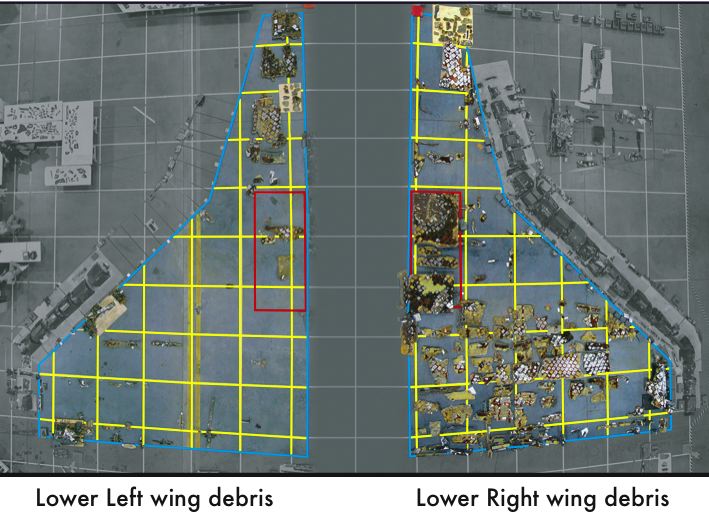
Figure 3.7-1. Comparison of amount of debris recovered from the left and right wings of Columbia. Note the amount of debris recovered from areas in front of the wheel well (the red boxes on each wing) were similar, but there were dramatic differences in the amount of debris recovered aft of each wheel well.
図3-7-1:コロンビアの左翼と右翼の回収された破片の量の比較。主着陸脚収納部(両翼の赤い四角で囲まれた部分)より前方では破片の回収量に大きな違いがないにもかかわらず、後方では非常に大きく違っているのに注意。
The difference in recovered debris from the Orbiters wings clearly indicates that after the breakup, most of the left wing succumbed to both high heat and aerodynamic forces, while the right wing succumbed to aerodynamic forces only. Be- cause the left wing was already compromised, it was the first area of the Orbiter to fail structurally. Pieces were exposed to higher heating for a longer period, resulting in more heat damage and ablation of left wing structural material. The left wing was also subjected to superheated air that penetrated directly into the mid-body of the wing for a substantial period. This pre-heating likely rendered those components unable to absorb much, if any, of the post-breakup heating. Those internal and external structures were likely vaporized during post-breakup re-entry. Finally, the left wing likely lost significant amounts of the Thermal Protection System prior to breakup due to the effect of internal wing heating on the Thermal Protection System bonding materials, and this further degraded the left wings ability to resist the high heat of re-entry after it broke up.
回収されたオービターの主翼の破片の量の違いは、左翼が空力的な力と高熱の両方の影響を受けており、右翼は空力的な力だけを受けたことをはっきりと示しています。つまり、左翼はすでに強度を失っていため、構造的な破壊が起きた最初の部分になったのです。破片はより長い時間より高い熱にさらされたため、より激しく溶融や破壊が起きていました。また、左翼には主翼中央部内に侵入した高熱の大気の影響を、かなり長時間受けていました。これらのパーツは、この空中分解前の熱の影響にために、分解後の熱に耐えられなかったのです。おそらく、これらの内部/外部の構造物は、空中分解後に蒸発してしまったでしょう。また、内部の熱のために耐熱システムの接着剤が弱くなり、空中分解の前にかなりのタイルが失われていたはずです。このタイルの喪失によって、さらに分解後の熱に対する耐久性が下がったのです。
Tile Slumping and External Patterns of Tile Loss
耐熱タイルの劣化と、タイルの脱落のパターン
Tiles recovered from the lower left wing yielded their own interesting clues. The left wing lower carrier panel 9 tiles sustained extreme heat damage (slumping) and showed more signs of erosion than any other tiles.This severe heat erosion damage was likely caused by an outflow of superheated air and molten material from behind RCC panel 8 through a U-shaped design gap in the panel (see Figure 3.7-2) that allows room for the T-seal attachment. Effluents from the back side of panel 8 would directly impact this area of lower carrier panel 9 and its tiles. In addition, flow lines in these tiles (see Figure 3.7-3) exhibit evidence of superheated airflow across their surface from the area of the RCC panel 8 and 9 interface. Chemical analysis shows that these carrier panel tiles were covered with molten Inconel, which is found in wing leading edge attachment fittings, and other metals coming from inside the RCC cavity. Slumping and heavy erosion of this magnitude is not noted on tiles from anywhere else on the Orbiter.
左翼の下部から回収された破片は、原因究明への興味深い手がかりとなりました。左翼下部9番キャリアパネルのタイルは、非常に高い熱によるダメージ(劣化)を受けており、また、他のタイルよりも浸食の跡が顕著でした。この高熱による浸食は、8番RCCパネルの後ろからT-シールのアタッチメントを収めるU字型の隙間(図3-7-2)を通じて流出した高熱の大気と溶けた金属によっておきたと思われます。この8番パネルの後ろからの流出物は下部9番キャリアパネルとそのタイルに直接吹き付けました。さらに、これらのタイルに残された空気の流れの跡(図3-7-2)は、高熱の大気が8番と9番RCCパネルの境目を超えて流れたことを示しています。化学分析によって、これらのキャリアパネルのタイルは溶けた合金で覆われていることが分かりました。この合金は主翼前縁部の結合金具やRCCパネル内の金属パーツに由来するものです。これほどまでの劣化と激しい浸食はオービターのほかの箇所のタイルでは見られませんでした。
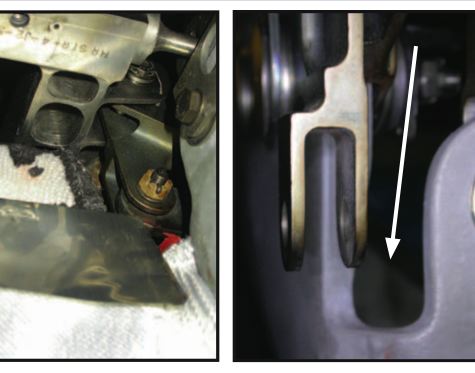
Figure 3.7-2. Each RCC panel has a U-shaped slot (see arrow) in the back of the panel. Once superheated air entered the breach in RCC panel 8, some of that superheated air went through this slot and caused substantial damage to the Thermal Protection System tiles behind this area.
図3-7-2: 各RCCパネルには、パネル背後にU字型のスロット(矢印)がある。いったん8番RCCパネルの破損部分から進入した高熱の大気はこのスロットを通って、このエリアの直後にある耐熱タイルに大きなダメージを与えた。
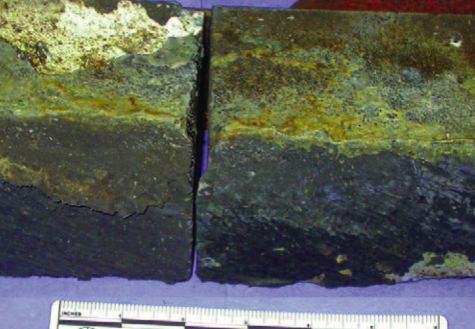
Figure 3.7-3. Superheated airflow caused erosion in tiles around the RCC panel 8 and 9 interface. The tiles shown are from behind the area where the superheated air exited from the slot in Figure 3.7-2. These tiles showed much greater thermal damage than other tiles in this area and chemical analysis showed the presence of metals only found in wing leading edge components.
図3-7-3: 高熱の大気の流れによって8番と9番RCCパネルの境目付近に侵食が生じている。これらのタイルは図3-7-2に示されるスロットから高熱の大気が流れ出た箇所の後ろの部分のもの。このエリアのタイルは他のものに比べて熱による損傷が激しく、また化学分析によって主翼前縁部内部にしかない金属が見つかった。
Failure modes of recovered tiles from the left and the right wing also differ. Most right wing tiles were simply broken off the wing due to aerodynamic forces, which indicates that they failed due to physical overload at breakup, not because of heat. Most of the tiles on the left wing behind RCC panels 8 and 9 show significant evidence of backside heating of the wing skin and failure of the adhesive that held the tiles on the wing. This pattern of failure suggests that heat penetrated the left wing cavity and then heated the aluminum skin from the inside out. As the aluminum skin was heated, the strength of the tile bond degraded, and tiles separated from the Orbiter.
右翼と左翼の破損の仕方も異なっていました。右翼のほとんどのタイルは空気力学的な力によって単純に脱落していました。これはこれらのタイルが熱ではなく空中分解のときの物理的な負荷によって破損したことを示しています。しかし、左翼の8番と9番RCCパネルの後ろのタイルは、主翼の裏側が熱にさらされ、タイルを主翼に貼り付けている接着剤が剥離しているのが発見されました。この破損のパターンは、熱が左翼内部の空間に侵入し、内部から主翼表面のアルミニウムを加熱したことを示唆しています。このアルミニウムの表面が熱せられるに従ってタイルの接着剤の粘着力が弱まり、タイルがオービターから脱落したのです。
Erosion of Left Wing Reinforced Carbon-Carbon
左翼の強化カーボンカーボンの侵食
Several pieces of left wing RCC showed unique signs of heavy erosion from exposure to extreme heat. There was erosion on two rib panels on the left wing leading edge in the RCC panel 8 and 9 interface. Both the outboard rib of panel 8 and the inboard rib of panel 9 showed signs of ex- treme heating and erosion (see Figure 3.7-4). This erosion indicates that there was extreme heat behind RCC panels 8 and 9. This type of RCC erosion was not seen on any other part of the left or right wing.
左翼のRCCの破片のいくつかには、高熱にさらされたことによる特有の侵食の跡が見られました。この侵食は左翼前縁部の8番と9番RCCパネルの境にある2つのリブパネルから見つかっています。8番パネルの外側と9番パネルの内側のそれぞれのリブパネルは高熱と侵食の跡が見られます(図3-7-4)。この侵食は8番と9番のRCCパネルの後ろで高熱が生じていたことを示してます。このタイプの侵食は左翼、右翼とも他の箇所では見つかっていません。
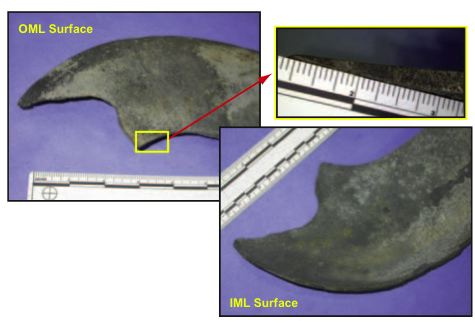
Figure 3.7-4. The outboard rib of panel 8 and the inboard rib of panel 9 showed signs of extreme heating and erosion. RCC ero- sion of this magnitude was not observed in any other location on the Orbiter.
図3-7-4:8番パネルの外側リブおよび9番パネルの内側リブに高熱と侵食の跡が見られる。このようなRCCの侵食はオービターのほかの箇所では見つかっていない。
Locations of Reinforced Carbon-Carbon Debris
強化カーボンカーボンの破片の回収位置
The location of debris on the ground also provided evidence of where the initial breach occurred. The location of every piece of recovered RCC was plotted on a map and labeled according to the panel the piece originally came from. Two distinct patterns were immediately evident. First, it was clear that pieces from left wing RCC panels 9 through 22 had fallen the farthest west, and that RCC from left wing panels 1 through 7 had fallen considerably farther east (see Figure 3.7-5). Second, pieces from left wing panel 8 were found throughout the debris field, which suggested that the left wing likely failed in the vicinity of RCC panel 8. The early loss of the left wing from RCC panel 9 and outboard caused the RCC from that area to be deposited well west of the RCC from the inboard part of the wing. Since panels 1 through 7 were so much farther to the east, investigators concluded that RCC panels 1 through 7 had stayed with the Orbiter longer than had panels 8 through 22.
地上で破片が回収された場所も、主翼のどの位置で最初の損傷が起きたかを立証する手がかりになりました。回収された全てのRCCの位置を、本来そのパネルが設置されていた場所に対応して色付けして地図上にプロットしたところ、直接の証拠となるふたつの明らかなパターンが見られました。一つ目は左翼の9番から22番パネルが極端に西寄りに、1番から7番のパネルがかなり東よりに落下していることです(図3-7-5)。ふたつ目は、左翼8番パネルの破片がエリア全体にわたって落下していたこと。これは、左翼の破壊が8番RCCパネル近辺から始まったことを示しています。9番RCCパネルおよびその外側のパネルが先に脱落したために、このエリアの破片が内側のパネルに比べて東よりに落下することになったのです。また、1番から7番のパネル(内側のパネル)はさらに東に落下しており、8番から22番のパネルに比べ長い間落下することなくオービターについていたと思われます。
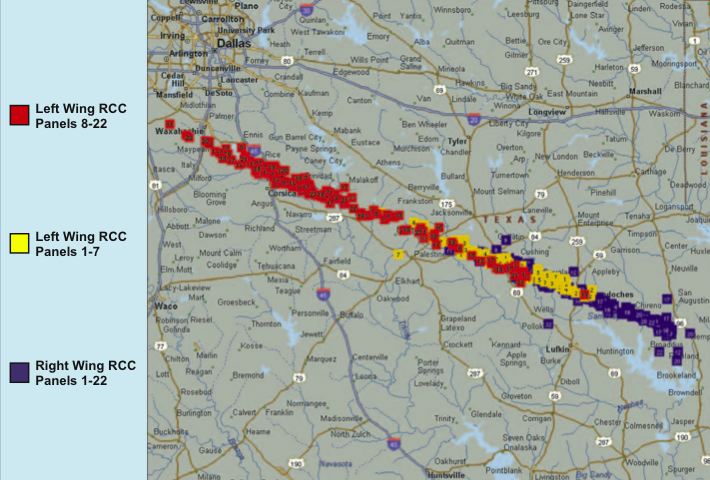
Figure 3.7-5. The location of RCC panel debris from the left and right wings, shown where it was recovered from in East Texas. The debris pattern suggested that the left wing failed before the right wing, most likely near left RCC panels 8 and 9.
図3-7-5: 東テキサスにおいて回収された両翼のRCCパネルの破片の位置。破片の落下パターンは、左翼が右翼よりも先に落下したこと、特に8番と9番RCCパネルから脱落が始まったことを示唆している。
Tile Locations
耐熱タイルの位置
An analysis of where tiles were found on the ground also yielded significant evidence of the breach location. Since most of the tiles are of similar size, weight, and shape, they would all have similar ballistic coefficients and would have behaved similarly after they separated from the Orbiter. By noting where each tile fell and then plotting its location on the Orbiter tile map, a distinctive pattern emerged. The tiles recovered farthest west all came from the area immediately behind the left wing RCC panel 8 and 9 (see Figure 3.7-6), which suggests that these tiles were released earlier than those from other areas of the left wing. While it is not conclusive evidence of a breach in this area, this pattern does suggest unique damage around RCC panels 8 and 9 that was not seen in other areas. Tiles from this area also showed evidence of a brown deposit that was not seen on tiles from any other part of the Orbiter. Chemical analysis revealed it was an Inconel-based deposit that had come from inside the RCC cavity on the left wing (Inconel is found in wing leading edge attachment fittings). Since the streamlines from tiles with the brown deposit originate near left RCC panels 8 and 9, this brown deposit likely originated as an outflow of su- perheated air and molten metal from the panel 8 and 9 area.
どの箇所のタイルが、地上のどの位置で発見されたかに関する情報も、主翼の破損がどこから始まったかに関する重要な証拠となりました。ほとんど全てのタイルが同じサイズ、重さ、形を持っていますから、それらは皆同じ弾道係数を持ち、オービターから脱落した後は同じように振舞ったはずです。そこで、各タイルがどこに落下したかを機体の図面上にプロットしてみると、特有のパターンが現れました。最も西から回収された破片は、すべて8番と9番RCCパネルの直後からのものだったのです(図3-7-6)。これは、このエリアのパネルが左欲のほかのエリアより先に脱落したことを示しています。これは、主翼の破損がこの位置だったことを示す決定的な証拠ではありませんが、8番と9番RCCパネルの付近に他のエリアには見られない損傷が起きたことをを示唆しています。また、この箇所のタイルからは、オービターのほかの部分からは見つからなかった褐色の付着物が見つかりました。化学分析によって。この付着物が左翼のRCCパネルの空洞部分にあるインコネルを主とするものであることが分かりました(インコネルは主翼前縁部の取付具に使われています)。左翼の8番と9番のRCCパネル付近から褐色の付着物を伴った流線型の跡があるため、この褐色の付着物は高温の空気と溶けた金属が8番と9番のRCCパネルから流れ出したものと思われます。
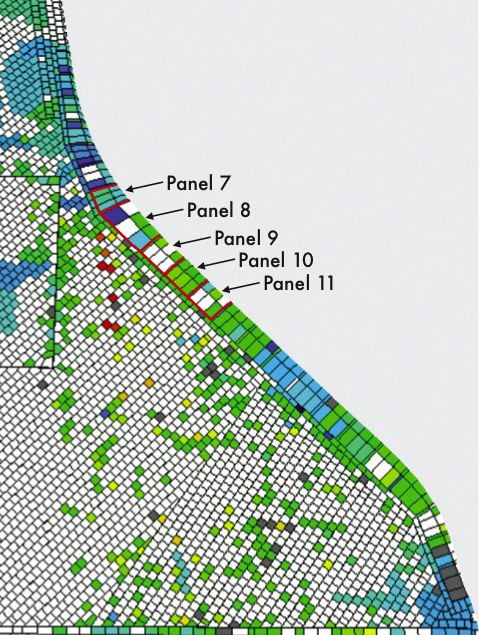
Figure 3.7-6. The tiles recovered farthest west all came from the area immediately behind left wing RCC panels 8 and 9. In the figure, each small box represents an individual tile on the lower surface of the left wing. The more red an individual tile appears, the farther west it was found.
図3-7-6:
最も西から回収されたタイルは、全て8番と9番RCCパネルの直後から脱落したもの。この図では、左翼下面の個々のタイルが小さな四角形で示されている。赤いパネルが最も西から発見されたパネル。
Molten Deposits
High heat damage to metal parts caused molten deposits to form on some Orbiter debris. Early analysis of these deposts focused on their density and location. Much of the left wing leading edge showed some signs of deposits, but the left wing RCC panels 5 to 10 had the highest levels.
オービターの破片の一部に見られた付着物は金属パーツへの高熱による損傷によって生じたと考えられます。この付着物に対する初期の分析はその位置と密度に注目して行われました。左翼前縁部のほとんどに沈着が見られましたが、特に5番から10番にかけてのRCCパネルが最も顕著でした。
Of all the debris pieces recovered, left wing panels 8 and 9 showed the largest amounts of deposits. Significant but lesser amounts of deposits were also observed on left wing RCC panels 5 and 7. Right wing RCC panel 8 was the only right-wing panel with significant deposits.
回収されたすべての破片のうち、最も付着物の量が多かったのは左翼の8番と9番パネルです。また、5番と7番のパネルにも、量は少ないもののはっきりと付着物がみられました。右翼で沈着が見つかったのは8番RCCパネルだけです。
Chemical and X-Ray Analysis
化学分析およびX線分析
Chemical analysis focused on recovered pieces of RCC panels with unusual deposits. Samples were obtained from areas in the vicinity of left wing RCC panel 8 as well as other left and right wing RCC panels. Deposits on recovered RCC de- bris were analyzed by crosssectional optical and scanning electron microscopy, microprobe analysis, and x-ray diffraction to determine the content and layering of slag deposits. Slag was defined as metallic and nometallic deposits that resulted from the melting of the internal wing structures. X-ray analysis determined the best areas to sample for chemical testing and to see if an overall flow pattern could be discerned.
化学分析は奇妙な付着物が見られたRCCパネルに焦点を合わせて行われました。左翼8番RCCパネル付近だけではなく、それ以外の左右の翼のRCCパネルからもサンプルが取られました。回収されたRCCの破片の付着物に対して断面の光学顕微鏡および走査型電子顕微鏡分析、マイクロプローブ分析、X線解析などが行われ、スラグの付着物の構成物と重なり方が明らかにされました。スラグは主翼の内部構造物が溶けたことによって生じた金属と金属以外の物質からなることが明らかになりました。また、X戦分析によって、化学テストを行う上で最適な場所が特定され、また、すべての空気の流れが判別できるかどうかが確認されました。
The X-ray analysis of left wing RCC panel 8 (see Figure 3.7-7) showed a bottom-to-top pattern of slag deposits. In some areas, small spheroids of heavy metal were aligned vertically on the recovered pieces, which indicated a super- heated airflow from the bottom of the panel toward the top in the area of RCC panel 8-left. These deposits were later determined by chemical analysis to be Inconel 718, prob- ably from the wing leading edge attachment fittings on the spanner beams on RCC panels 8 and 9. Computational fluid dynamics modeling of the flow behind panel 8 indicated that the molten deposits would be laid down in this manner.
左翼8番パネルのX線分析(図3-7-7)には、底面から上に向かってスラグの付着物のあとが残っていました。いくつかの領域では、回収された破片に重金属の小さな球体が縦方向に並んでいるのが発見されました。これは、超高温の大気の流れが8番RCCパネルの左側を底面から上に向かって吹き抜けたことを示しています。これらの付着物は、化学分析によって、おそらく8番9番RCCパネルの横桁上の主翼前縁部取付具に由来するインコネル718であることが明らかにされました。流体力学的なシミュレーションは、8番パネルの後ろ部分の空気の流れが、溶けた物質の付着物がこのようなパターンになることを示唆しています。
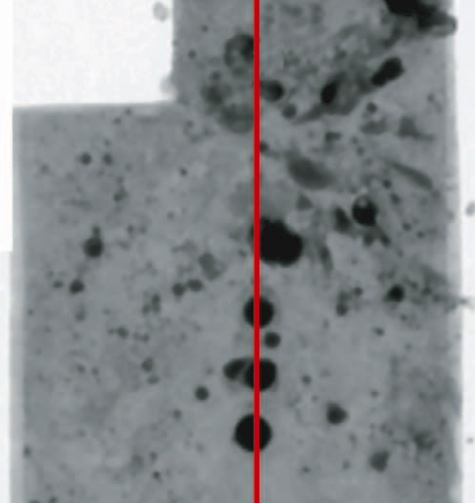
Figure 3.7-7. X-ray analysis of RCC panel 8-left showed a bottom- to-top pattern of slag deposits.
図3-7-7: X線分析による8番RCCパネルの左側の画像。スラグの付着物が底面から上に向かって並んでいる。
The layered deposits on panel 8 were also markedly different from those on all other left- and right-wing panels.There was much more material deposited on RCC panel 8-left. These deposits had a much rougher overall structure, including rivulets of Cerachrome slag deposited directly on the RCC. This indicated that Cerachrome, the insulation that protects the wing leading edge spar, was one of the first materials to succumb to the superheated air entering through the breach in RCC panel 8-left. Because the melting temperature of Cerachrome is greater than 3,200 degrees Fahrenheit, analysis indicated that materials in this area were exposed to extremely high temperatures for a long period. Spheroids of Inconel 718 were mixed in with the Cerachrome. Because these spheroids (see Figure 3.7-8) were directly on the surface of the RCC and also in the first layers of deposits, investigators concluded that the Inconel 718 spanner beam RCC fittings were most likely the first internal structures subjected to intense heating. No aluminum was detected in the earliest slag layers on RCC panel 8-left. Only one location on an up- per corner piece, near the spar fitting attachment, contained A-286 stainless steel.This steel was not present in the bottom layer of the slag directly on the RCC surface, which indicated that the A-286 attachment fittings on the wing spar were not in the direct line of the initial plume impingement.
8番パネル上に重なった付着物は他の左右の翼のパネルとは全く違うものでした。8番RCCパネルの左側面には大量の沈着物があったのです。この沈着物の表面は他のどんな構造物より―RCCパネル上に直接セラクロームの細流を流したものよりもはるかに荒いものでした。これは主翼前縁部桁の保護材であるセラクロームが、8番RCCパネル左側の破損箇所から流れ込んだ高温の空気に最初に屈した物質だったことを示しています。セラクロームの融点は華氏3200度(摂氏1760度)以上であることから、このエリアは超高温の空気に長い時間さらされていたことが分かります。インコネル718の球体はセラクロームとの混合物になっていました。これらの球体(図3-7-8)がRCCの表面にあり、付着物の一番下の層だったことから、調査員はRCC接続金具の横桁に使われていたインコネル718が、高熱に最初にさらされた内部構造物だったという結論に達しました。RCCパネル左側のスラグの初期の層からはアルミニウムは発見されていません。A-286ステンレス鋼が含まれていたのはパネルの上の角、桁接続金具付近だけでした。この合金はスラグの一番下の層、つまりRCCパネルの表面には存在しなかったことから、主翼桁のA-286接続具は最初に侵入した高熱の大気の流れの直線上になかったことが分かります。
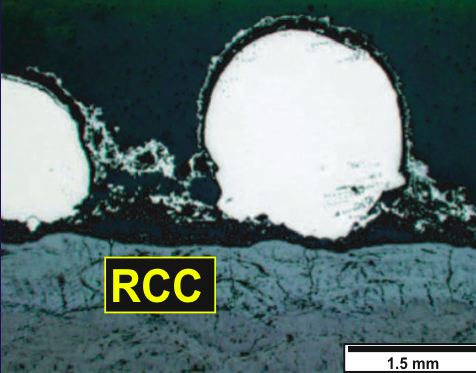
Figure 3.7-8. Spheroids of Inconel 718 and Cerachrome were deposited directly on the surface of RCC panel 8-left. This slag deposit pattern was not seen on any other RCC panels.
図3-7-8: インコネル718とセラクロームの球体が8番RCCパネル左側面の表面上に見られる。このスラグの付着のパターンは他のRCCパネルには見られない。
In wing locations other than left RCC panels 8 and 9, the deposits were generally thinner and relatively uniform. This suggests no particular breach location other than in left RCC panels8 and 9.These other slag deposits contained primarily aluminum and aluminum oxides mixed with A-286, Inconel, and Cerachrome, with no consistent layering. This mixing of multiple metals in no apparent order suggests concurrent melting and redepositing of all leading-edge components, which is more consistent with post-breakup damage than the organized melting and depositing of materials that occurred near the original breach at left RCC panels 8 and 9. RCC panel 9-left also differs from the rest of the locations analyzed. It was similar to panel 8-left on the inboard side, but more like the remainder of the samples analyzed on its outboard side. The deposition of molten deposits strongly suggests the original breach occurred in RCC panel 8-left.
左翼の8番と9番RCCパネル以外の部分では、付着物は薄く、比較的均一でした。これは8番と9番RCCパネル以外の部分には特定の破損箇所がなかったことを示しています。この他のスラグの付着物は主にアルミニウムとアルミニウムの酸化物にA-286、インコネル、セラクロームが混ざったものです。複数の金属が層にならずに混ざり合っていることから、主翼前縁部の構造物がすべて同時に溶けたものが、再びパネル表面に付着したと考えられます。これは、先に述べた最初の破損箇所である左翼の8番と9番RCCパネル付近で起きた初期の溶融とスラグの付着ではなく、空中分解寸前に起きたものと考える方が自然です。また、9番RCCパネルの左側にも、他の箇所と違った所がありました。胴体側にあたる8番パネルの左側面と似ていましたが、むしろ8番パネルの外側(右側)から取られたサンプルとより似通っていました。これは、最初の破損が8番RCCパネルの左側に起きたことを強く示唆するものです。
Spanner Beams, Fittings, and Upper Carrier Panels
横桁、結合金具、 上部キャリアパネル
Spanner beams, fittings, and upper carrier panels were recovered from areas adjacent to most of the RCC panels on both wings. However, significant numbers of these items were not recovered from the vicinity of left RCC panels 6 to 10. None of the left wing upper carrier panels at positions 9, 10, or 11 were recovered. No spanner beam parts were recovered from the left RCC panel 8 to 10 area. No upper or lower RCC fittings were recovered for left panels 8, 9, or 10. Some of this debris may not have been found in the search, but it is unlikely that all of it was missed. Much of this structure probably melted, and was burned away by superheated air inside the wing. What did not melt was so hot that when it broke apart, it did not survive the heat of re-entry.This supports the theory that superheated air penetrated the wing in the general area of RCC panel 8-left and caused considerable structural damage to the left wing leading edge spar and hardware.
横桁、結合金具、 および上部キャリアパネルは両翼のRCCパネルの大部分が発見された地域と隣接した場所から回収されました。しかし、同パーツの大半は左翼の6番から10番RCCパネル付近からは回収されませんでした。また、左翼9番、10番、11番の上部キャリアパネルは発見されませんでした。さらに、左翼8番から10番RCCパネルの上部と下部のRCCパネル結合金具も回収されませんでした。これらのパーツのいくつかは捜索で発見されなかったかもしれませんが、これらすべてが回収に失敗したとは考えにくいでしょう。これらの多くは、主翼内の高温の空気によっておそらく溶けるか、燃え尽きてしまったと思われます。溶けなかったパーツも、機体の分解時にすでに非常に高温になっていたため、再突入に耐えられませんでした。この考え方は高温の大気が8番RCCパネル付近から主翼内に侵入し、左翼前縁部桁とその付近のパーツに重大な損傷を与えたというシナリオを支持するものです。
Debris Analysis Conclusions
破片の分析の結論
A thorough analysis of left wing debris (independent of the preceding aerodynamic, aerothermal, sensor, and photo data) supports the conclusion that significant abnormalities occurred in the vicinity of left RCC panels 8 and 9. The pre- ponderance of debris evidence alone strongly indicates that the breach occurred in the bottom of panel 8-left.The unique composition of the slag found in panels 8 and 9, and espe- cially on RCC panel 8-left, indicates extreme and prolonged heating in these areas very early in re-entry.
左翼の破片の分析(および、これに先行する独立した空気力学、熱空気力学、センサー、画像などのデータ)は、重大な異常が左翼8番と9番のRCCパネル付近で起きたという結論を支持するものでした。破片の分析から得られた証拠だけでも、最初の破損箇所が8番パネル左側の底の部分だったことを強く示唆しています。また、他の箇所には見られない組成を持ったスラグが8番と9番パネル―特に8番パネル左側に残っており、このエリアが再突入の最初機の段階から、長時間にわたって、異常な高温にさらされていたことを示唆しています。
The early loss of tiles in the region directly behind left RCC panels 8 and 9 also supports the conclusion that a breach through the wing leading edge spar occurred here. This allowed superheated air to flow into the wing directly behind panel 8.The heating of the aluminum wing skin degraded tile adhesion and contributed to the early loss of tiles.
8番、9番RCCパネルのすぐ後ろのエリアで起きた初期のタイルの脱落は、主翼前縁部桁の破損箇所がこのエリアだったという結論を支持するものです。これによって、高温の空気が8番パネルの背後の領域に侵入しました。アルミニウム製の翼の表面が熱せられたためにタイルの接着力が低下し初期の脱落を招いたと考えられます。
Severe damage to the lower carrier panel 9-left tiles is indicative of a flow out of panel 8-left, also strongly suggesting that the breach in the RCC was through panel 8-left. It is noteworthy that it occurred only in this area and not in any other areas on either the left or the right wing lower carrier panels. There is also significant and unique evidence of severe "knife edges" erosion in left RCC panels 8 and 9. Lastly, the pattern of the debris field also suggests the left wing likely failed in the area of RCC panel 8-left.
9番左側の下部キャリアパネルの激しい損傷は、8番パネル左側からの空気の流れを示唆するものです。また、このことはRCCパネルの損傷箇所がパネル8番左側だったことを強く示唆しています。この種の損傷が、左右の主翼の他のどの下部キャリアパネルでも起こっていないことは注目に値します。また、8番と9番RCCパネルには、他の箇所では見られない「ナイフの刃」のような浸食が見られました。さらに、破片の散乱状況も主翼の崩壊がRCCパネル8番左側から始まったことを示唆しています。
The preponderance of unique debris evidence in and near RCC panel 8-left strongly suggests that a breach occurred here. Finally, the unique debris damage in the RCC panel 8-left area is completely consistent with other data, such as the ModularAuxiliary Data System recorder, visual imagery analysis, and the aerodynamic and aerothermal analysis.
8番RCCパネル左側付近の破片の他に見られない特徴は、破損がここにあったことを強く示唆するものです。また、この損傷は、補助データモジュールシステムや画像分析、空気力学、熱空気力学敵な分析などの結果と完全に一致しています。
Findings:
所見:
F3.7-1
Multiple indications from the debris analysis establish the point of heat intrusion as RCC panel 8-left.
Multiple indications from the debris analysis establish the point of heat intrusion as RCC panel 8-left.
F3.7-1
破片の分析によって得られた複数の兆候が、 高熱の空気が侵入した場所が8番RCCパネルだったことを示している。
破片の分析によって得られた複数の兆候が、 高熱の空気が侵入した場所が8番RCCパネルだったことを示している。
F3.7-2
The recovery of debris from the ground and its reconstruction was critical to understanding the accident scenario.
The recovery of debris from the ground and its reconstruction was critical to understanding the accident scenario.
F3.7-2
地上での破片の回収と復元作業は事故のシナリオを理解する上で決定的な役割を果たした。
地上での破片の回収と復元作業は事故のシナリオを理解する上で決定的な役割を果たした。
Recommendations:
勧告:
None
特になし
STS-107 CREW SURVIVABILITY